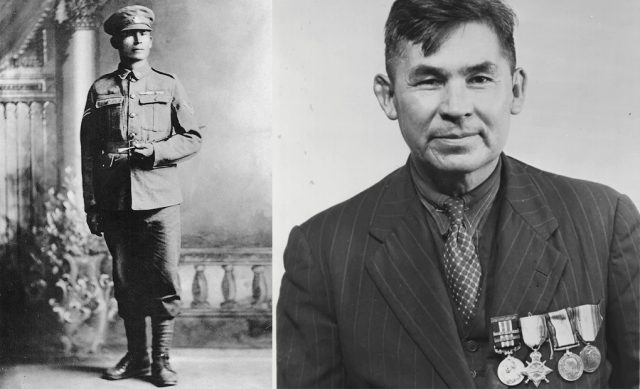
September 1914 – Joined the 1st Canadian Infantry Battalion.
October 1914 – Sailed to England on the SS Laurentic.
April 1915 – Survived the Second Battle of Ypres, where the 1st Battalion lost half its men.
June 1916 – Fighting at the Battle of Mount Sorrel, he was accredited for capturing 300 German prisoners.
July 1916 – Shot in the leg at the Battle of the Somme.
1916 – Became one of the first Canadians to receive the Military Medal: “For continuous service as a messenger from February 14th, 1915, to February 1916. He carried messages with great bravery and success during the whole of the actions at Ypres, Festubert and Givenchy. In all his work he has consistently shown a disregard for danger and his faithfulness to duty is highly commendable.”
November 1917 – Involved in the Second Battle of Passchendaele, where he won the first bar to his military medal for helping to capture the ridge: “At Passchendaele Nov. 6th/7th, 1917, this NCO [non-commissioned officer] did excellent work. Before and after the attack he kept in touch with the flanks, advising the units he had seen, this information proving the success of the attack and saving valuable time in consolidating. He also guided the relief to its proper place after it had become mixed up.”
August 1918 – Received the second bar to his military medal during the Battle of the Scarpe: “During the operations of August 30, 1918, at Orix Trench, near Upton Wood, when his company were almost out of ammunition and in danger of being surrounded, this NCO went over the top under heavy MG [machine gun] and rifle fire and brought back sufficient ammunition to enable the post to carry on and assist in repulsing heavy enemy counter-attacks.”
May 1919 – After serving for the entirety of the war, Francis was demobilized. He came home to later become chief of the Parry Island Band. He got married and had eight children.
August 1952 – Francis passed away at his home on the Parry Island Reserve.
Submitted by: Base Borden Military Museum
Photo courtesy of Base Borden Military Museum
Sergeant Major Francis Pegahmagabow : sa chronologie
Septembre 1914 – Il se joint au 1er Bataillon d’infanterie.
Octobre 1914 – Il traverse en Angleterre à bord du SS Laurentic.
Avril 1915 – Il participe à la deuxième bataille d’Ypres.
Juin 1916 – Il est de la bataille du mont Sorrel, où on lui attribue la capture de 300 soldats allemands.
Juillet 1916 – Il reçoit une balle dans la jambe à la bataille de la Somme.
1916 – Il devient un des premiers Canadiens à recevoir la Médaille militaire : « Pour son service continu comme messager du 14 février 1915 à février 1916. Il a transporté des messages avec bravoure et succès pendant toutes les actions à Ypres, à Festubert et à Givenchy. Pendant son travail, il ne s’est jamais soucié du danger et sa fidélité au service est digne de mention. »
Novembre 1917 – Il prend part à la deuxième bataille de Passchendaele, où il reçoit la première barrette de sa Médaille militaire pour sa contribution à la prise de la crête : « À Passchendaele, les 6 et 7 novembre 1917, ce sous-officier fit un excellent travail. Avant et après l’attaque, il se tint en contact avec les flancs, les informant des unités qu’il avait vues, renseignements confirmant le succès de l’attaque et permettant de gagner un temps précieux pour l’opération de regroupement. Il conduisit en outre la relève à l’endroit où elle devait se trouver, après qu’elle se fut égarée. »
Août 1918 – Il reçoit la deuxième barrette de sa Médaille militaire à la bataille de Scarpe : « Pendant les opérations du 30 août 1918, dans la tranchée d’Orix, près du bois Upton, tandis que sa compagnie n’avait presque plus de munitions et était en danger d’être encerclée, ce sous-officier partit à l’assaut sous le feu nourri des mitrailleuses et des fusils afin de ramener suffisamment de munitions pour permettre au poste de continuer l’attaque et d’aider à repousser les contre-attaques massives de l’ennemi. »
Mai 1919 – Après avoir servi pendant l’entièreté de la guerre, le SM Pegahmagabow est démobilisé. Il revient à la maison pour devenir plus tard chef de la bande de Parry Island. De plus, il se mariera et aura huit enfants.
Août 1952 – Le SM Pegahmagabow s’éteint à son domicile, dans la réserve de Parry Island.
Soumis par : Musée militaire de la BFC Borden
Photo : Gracieuseté du Musée militaire de la base Borden.





